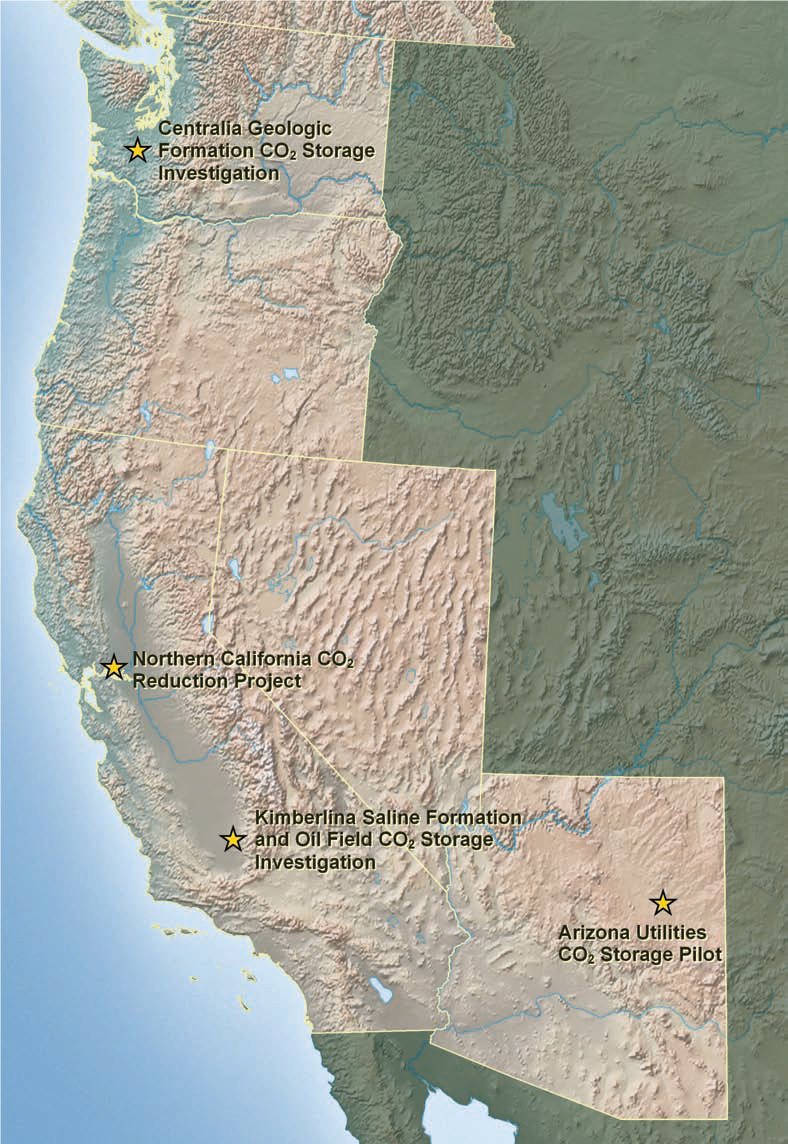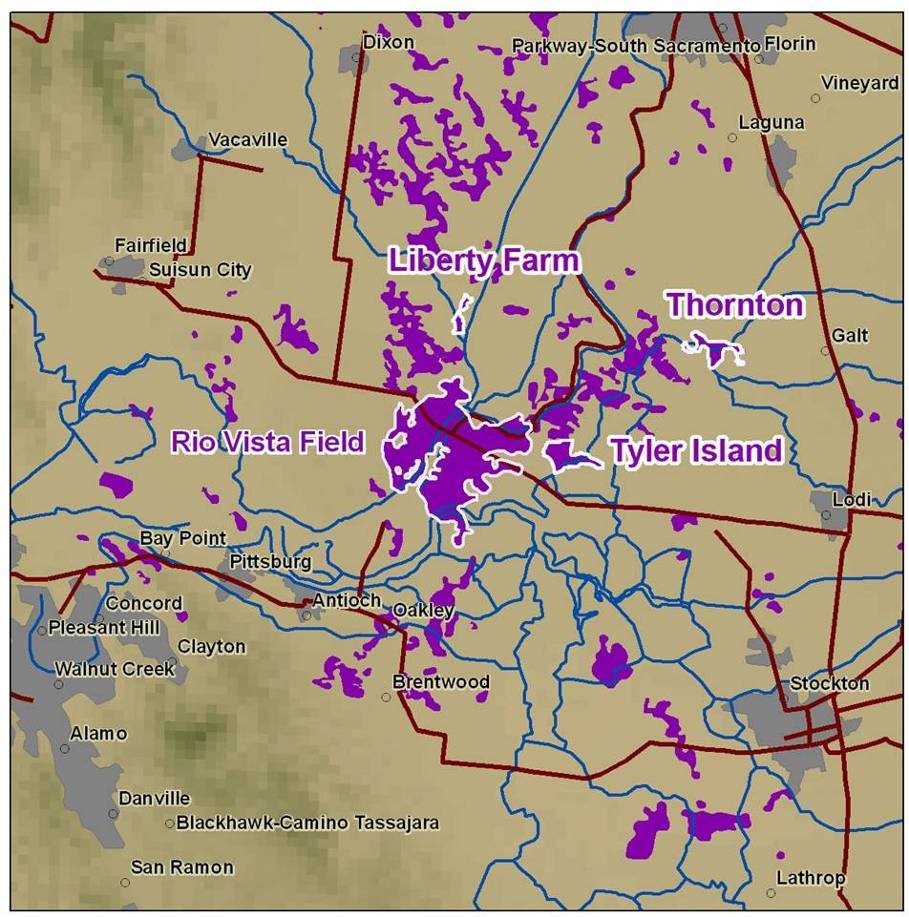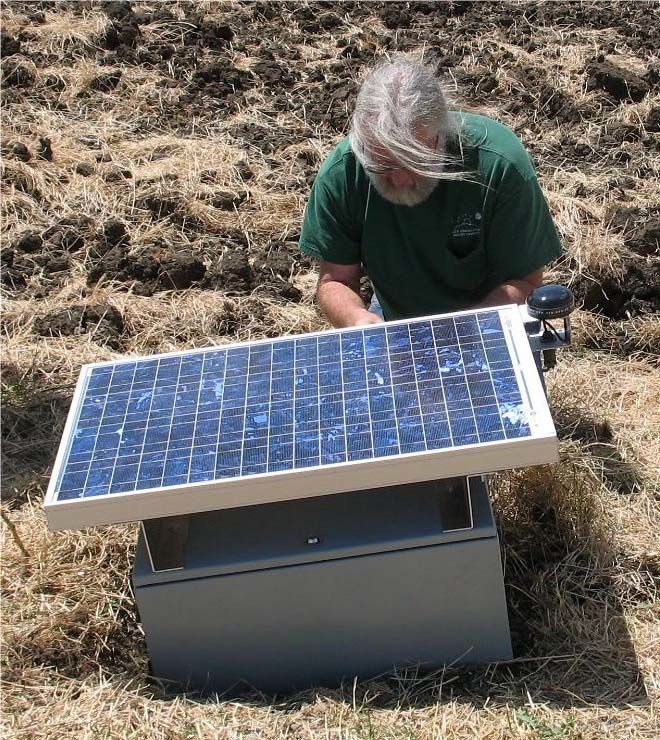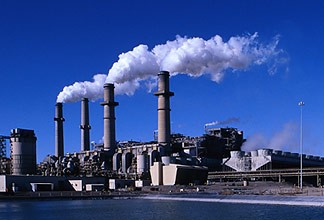Scale-Up to Phase II
The West Coast Regional Carbon Sequestration Partnership’s (WESTCARB) Phase II efforts built upon the regional characterization done in Phase I by expanding and updating regional geologic and terrestrial storage resource estimates, and by focusing on testing the most promising storage technologies at sites broadly representative of the region’s largest storage opportunities.
Geologic storage formations tested included saline formations (which have the region’s largest storage capacity) and methane-bearing coal-bed formations, where cost offsets could potentially improve economics. One geologic carbon dioxide (CO2) storage pilot was completed at a saline formation storage site in close proximity to an existing fossil power plant in Arizona. Site-specific investigations were carried out for two additional saline formation geologic pilots in California’s Central Valley, and an enhanced coalbed methane (ECBM) stacked storage pilot at a site in close proximity to an existing fossil power plant in Washington state. These efforts represented important steps in the scale-up of carbon capture and storage (CCS) in the WESTCARB region by focusing on demonstrating the safe and secure storage of CO2 in small-scale field pilots, providing experience with the public and regulatory agencies for permitting storage projects, and providing site-specific information for improving capacity estimation, monitoring technology, and risks assessment methodologies.
Two terrestrial CO2 storage pilots were also carried out, each focusing on the region’s largest terrestrial storage opportunities: reforestation of once-forested lands, forest fuel-load reduction to reduce CO2 releases from wildfires, and improved forest management to increase standing timber carbon storage.
Story of Intrest
In 2010, the California Energy Commission, California Public Utilities Commission, and the Air Resources Board formed the Carbon Capture and Storage (CCS) Review Panel to look at regulatory and statutory barriers to implementing CCS in California. The panel, composed of experts from industry, trade groups, academia, and environmental organizations, was asked to: (1) identify, discuss, and frame specific policies addressing the role of CCS technology in meeting the state’s energy needs and greenhouse gas (GHG) emissions reduction strategies for 2020 and 2050; and (2) support development of a legal/regulatory framework for permitting proposed CCS projects consistent with the state’s energy and environmental policy objectives. The panel held five public meetings in 2010 that were designed to solicit input from technical experts and key stakeholders. The report, “Final Recommendations of the Panel,” was released in 2011 and was a resource document for the 2018 California Carbon Capture and Sequestration Protocol under the Low-Carbon Fuel Standard (LCFS). The protocol, which was passed as an amendment to California's LCFS, incentivizes onshore CCS projects, in either saline or depleted oil and gas reservoirs, that reduce the lifecycle emissions from bioethanol, hydrogen, and crude, provided the fuel is sold into the California market. The West Coast Regional Carbon Sequestration Partnership (WESTCARB) researchers served on the Technical Advisory Committee to the panel, providing technical expertise during their deliberations and contributing to the Background Report accompanying the recommendations. region.
Regional Accomplishments
The Regional Technology Implementation Plan (RTIP), developed from work completed by the West Coast Regional Carbon Sequestration Partnership (WESTCARB), provided an overview of the status of carbon capture and storage (CCS) technology in the western United States and identified three barriers to successful deployment: (1) a lack of legislation encouraging carbon storage projects; (2) the high cost associated with carbon storage; and (3) lack of public understanding or acceptance on the subject. During Phase II, WESTCARB worked to validate carbon storage by addressing these challenges. Contributions were made to the regulatory aspects of CCS in California by informing and supporting the California CCS Review Panel, a group formed to advise policymakers on creating legal framework for permitting CCS projects. A regional geologic characterization assessment was completed for Alaska, Oregon, and California, providing revised storage estimates for the West Coast. This geologic assessment was assembled into a submission for Version 2 of the U.S. Department of Energy’s (DOE) Carbon Storage Atlas, providing updated storage capacity estimates and adding information on commercialization opportunities. WESTCARB sponsored many community outreach efforts intended to help inform the public on CCS, and increased awareness of geologic storage throughout the region through presentations to state agencies, professional organizations, industry trade groups, community leaders, general public, and policymakers. The potential for terrestrial storage was explored for Washington, Oregon, California, and Arizona. Two successful pilot projects showed promising results for the region, and landowners were willing to participate and even share the costs.
Research vs. Commercial
The West Coast Regional Carbon Sequestration Partnership’s (WESTCARB) Phase II efforts served as important first steps in development of commercial projects in the region. The efforts served to assess and demonstrate the region’s key carbon storage opportunities through small-scale pilot projects, methodology development, and market validation. WESTCARB’s research informed policymakers, communities, and businesses on how to invest in carbon capture and storage (CCS) technology development and deployment to reduce greenhouse gas (GHG) emissions.
During Phase II geologic pilots, the validation of the site, source, permitting, and operations planning took place. Requirements were set through project goals, permitting requirements, and site safety requirements. Researchers developed and tested project plans, including well spacing, injection rates and volumes, and monitoring techniques, to meet these requirements. However, the small scale and lack of carbon dioxide (CO2) injection during WESTCARB’s Phase II geologic storage projects made them very different than commercial operations.
The Phase II terrestrial storage projects characterized areas for afforestation and analyzed the storage capacity of different plants. Funding for the Phase II projects relied heavily on government funding and partner support; however, cost-effective procedures must be used at commercial sites to support the operations. Researchers also analyzed the cost of capture and storage at the selected sites, as the project must be economically favorable to move forward.
Partners
Greenwood Enterprises
Science Strategies
SFA Pacific
Cement Industry Environmental Consortium











